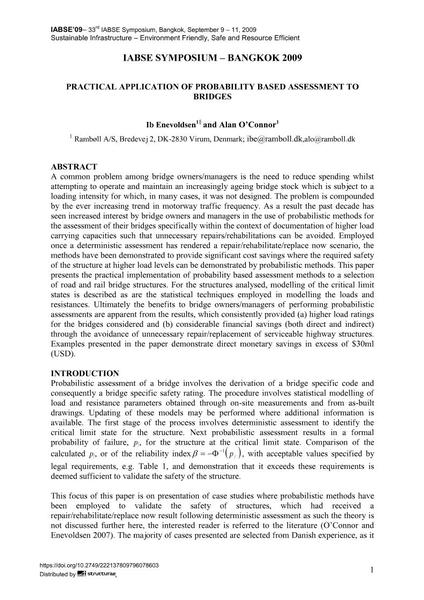Practical Application of Probability Based Assessment to Bridges

|
|
|||||||||||
Bibliographic Details
| Author(s): |
Ib Enevoldsen
(Rambøll A/S, Bredevej 2, DK-2830 Virum, Denmark)
Alan O'Connor (Rambøll A/S, Bredevej 2, DK-2830 Virum, Denmark) |
||||
|---|---|---|---|---|---|
| Medium: | conference paper | ||||
| Language(s): | English | ||||
| Conference: | IABSE Symposium: Sustainable Infrastructure - Environment Friendly, Safe and Resource Efficient, Bangkok, Thailand, 9-11 September 2009 | ||||
| Published in: | IABSE Symposium Bangkok 2009 | ||||
|
|||||
| Page(s): | 36-43 | ||||
| Total no. of pages: | 8 | ||||
| Year: | 2009 | ||||
| DOI: | 10.2749/222137809796078603 | ||||
| Abstract: |
A common problem among bridge owners/managers is the need to reduce spending whilst attempting to operate and maintain an increasingly ageing bridge stock which is subject to a loading intensity for which, in many cases, it was not designed. The problem is compounded by the ever increasing trend in motorway traffic frequency. As a result the past decade has seen increased interest by bridge owners and managers in the use of probabilistic methods for the assessment of their bridges specifically within the context of documentation of higher load carrying capacities such that unnecessary repairs/rehabilitations can be avoided. Employed once a deterministic assessment has rendered a repair/rehabilitate/replace now scenario, the methods have been demonstrated to provide significant cost savings where the required safety of the structure at higher load levels can be demonstrated by probabilistic methods. This paper presents the practical implementation of probability based assessment methods to a selection of road and rail bridge structures. For the structures analysed, modelling of the critical limit states is described as are the statistical techniques employed in modelling the loads and resistances. Ultimately the benefits to bridge owners/managers of performing probabilistic assessments are apparent from the results, which consistently provided (a) higher load ratings for the bridges considered and (b) considerable financial savings (both direct and indirect) through the avoidance of unnecessary repair/replacement of serviceable highway structures. Examples presented in the paper demonstrate direct monetary savings in excess of $30ml (USD). |
||||
